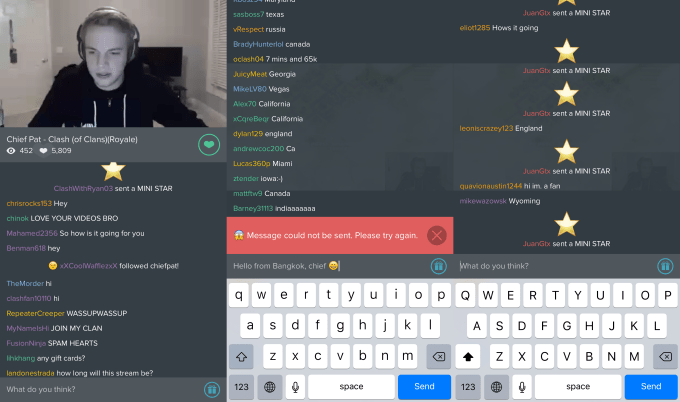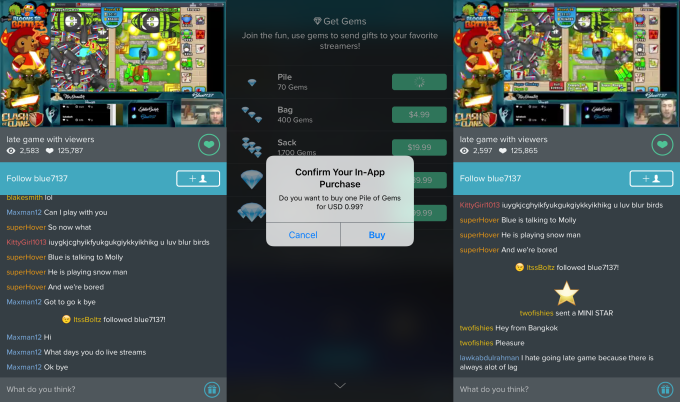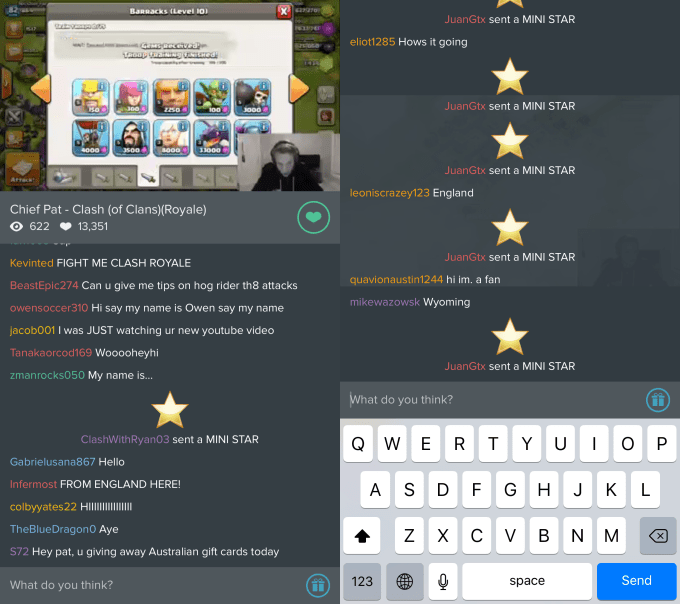Kamcord, the Y Combinator startup that wants to do to mobile what streaming service Twitch has done to console and PC gaming, has rolled out an important update after it began allowing its most prominent broadcasters to make money on its service.
Twitch, which streamers more video to users per month than even YouTube, grew into a beast that Amazon bought for just shy of $1 billion. The e-commerce firm had to beat off competition from Google, which is working to develop its own game-streaming service, too. While both are focused on desktop PC and console gamers, Kamcord is fixing its gaze on mobile, and mobile only.
So far, so promising — Kamcord has raised over $15 million and it has “millions” of users, the average (active) one of whom watches twenty minutes of video streaming each day. Now the startup is preparing for its third significant product release in six months which will finally turn on the revenue tap.
Major Updates
This summer, Kamcord added live streaming to its app and then, in December, it pushed a major update that allowed all users with Android devices to live stream their games. That update, which is not available on iOS, increased the number of Kamcord users streaming on the platform ten fold over the past six weeks, and now the next phase is to help these broadcasters — who are responsible for bringing users and eyeballs to the service — make money.
That will be in the form of virtual goods, digital items that fans can buy and send to broadcasters while they stream. When sent, they take break up the next within the comments section and help a user who purchased the item stand out from the others watching.
Not all users can earn money, however. Kamcord has created a partner program, only broadcasters included inside that can make money. The startup didn’t disclose its revenue share with partners but, crucially, this will represent the first time that it has monetized its service.
Kamcord co-founder Adi Rathnam told TechCrunch that the company has deliberately taken its time over making money, and that it was inspired by virtual goods business models that have seen success in China, Korea and other parts of Asia.
Rathnam said Kamcord users spend a lot of time trying to get the attention of their favorite broadcaster, but have to battle the noise from others. Galadon, the top followed Kamcord partner, has over 120,000 followers and regularly clocks tens of thousands of viewers for each live stream. His fans try their best to catch his attention during streams with comments, but paying upwards of $0.20 for a virtual good like a star can help stand out. (The top item, a mega star, costs $80 and takes up the full chat window.) There’s also an option to donate money to a partner via PayPal.

The volume of viewers on ChiefPat’s stream made even commenting difficult
“We spent a lot of time thinking about the underlying psychology behind it,” Rathnam said. “It’s not unlike buying a VIP pass to Taylor Swift, [just for a] chance to meet her for a selfie. This is a chance [for Kamcord users] to stand out and have an interaction with this person.”
Rathnam believes that a combination of factors makes streaming idols more popular with young people — the so-called Gen-S: generation screen — than traditional celebrities. Accessibility, interaction and having things in common — many still live with their parents as many of Kamcord’s users do — drive that fandoom, he explained.
For the broadcasters themselves, the addition of monetization represents an opportunity to make a living, or at least pocket money, from doing what they love: playing games on mobile. For now, Kamcord is the only service offering this on smartphones.
“Twitch cues towards core games on desktop… and it’s too hardcore [for mobile,]” Rathnam. “It would be like using LinkedIn to upload your vacation photos.”
As for YouTube, Rathnam said the streamers that he talks to feel that they are “low down on the list” of priorities for YouTube, which also musicians, comedians, artists and other entertainment stars.
That’s good news for Kamcord because, not only can it offer something unique, but it knows exactly where to go to find potential new broadcast partners: on Twitch or YouTube. And if you can bring establish content makers and keep them happy, then they will bring their audience, too.
Standing Out
Well, at 33 years old and with two kids, I’m hardly the average Kamcord user, so I took the plunge and checked out a live stream and sent a virtual gift to a broadcast partner.

The experience was pretty slick, a quick in-app purchase and I was armed with 70 gems ($0.99). I started out low, dishing out a mini star (15 gems) but the feedback was instant. While admittedly the stream I sat in on — blue7137 — wasn’t as busy as Galladon or Chief Pat, I was immediately called out by name and thanked. It seemed to be a big deal for the broadcaster, a signal that I (or anyone else) was prepared to go beyond chat and stump up some money to show appreciation.
A Promising Start
Virtual goods have been live on Kamcord across most of the world for a week now. During that time, the company has increased its partner base from an initial 100 to 175. Rathnam said the plan is to reach 1,000 partners “as soon as possible” — and that, already, new partners are gaining tens of thousands of followers.
“We thought [the model] might take a little work in the U.S., but we’re blown away with what we’ve seen in the U.S.. People often make a big deal about cultural differences worldwide, but a lot of the underlying human emotions are the same — [there’s a] willingness to go to extraordinary lengths to interact with idols,” he explained, adding that monetization is already on track for $1 million annual run rate.

Recent updates have added live streaming, broadcasting and virtual goods to the service, that’s a lot of change, and Kamcord plans more steady and incremental changes in 2016. Rathnam said there’s be a focus on tightening the interactions between broadcaster partners and their fans, increase the number of partners, working closely with game makers, and hiring backend engineers to scale the service.
Update: The article has been correct to reflect the fact that Galadon does not still live with his mum. Our apologies for any miscommunicate.
